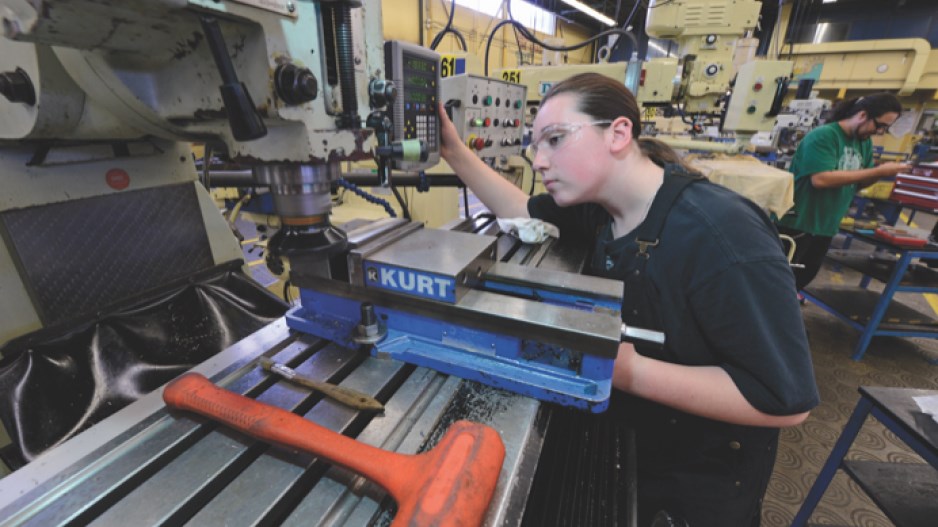By 2022, there will be one million job openings, one-third of which would be new jobs, the British Columbia government estimates. The rest would be replacement jobs for retiring baby boomers.
More than 40% of the new jobs would be in skilled trades and technical occupations, driven by an anticipated boom in mining, forestry, dam and pipeline construction and a new liquefied natural gas industry in northern B.C.
Chelsea Barron is at the vanguard of this new wave of skilled tradesmen and tradeswomen. When the boom times come, she plans to be ready for it.
Last week, the 20-year-old Vancouver resident, who is status Indian on her mother’s side, finished a first-year machinist’s course through the Aboriginal Community Career Employment Services Society (Access) program.
She’s now looking to get hired as an apprentice, so that she can get her red seal journeyman’s certification – something that will take three more years.
“I really enjoy doing this kind of work, and the amount of jobs and opportunities in the future are really, really high,” said Barron, whose father and brother are also both skilled tradesmen.
Since it was founded eight years ago, the Access program, which works in partnership with the Industrial Training Authority (ITA), has graduated 500 trades students, 80 of whom have gone on to get their red seal certification, which qualifies them to work anywhere in Canada.
Since there is high unemployment among many First Nations – especially in the regions where industry is beginning to boom – there has been a push on in recent years to train more aboriginal people in industrial trades.
“We’ve more than doubled the number of aboriginal people in the skilled trades since 2008 and [2009],” said Gary Herman, interim CEO of the ITA, which helps fund trades training in B.C. universities and colleges. “We currently have over 1,500 who have participated in the programs.”
Though Barron said she will go wherever the work is, she hopes to get a job in the Lower Mainland. And therein lies one of the biggest challenges when it comes to matching a domestic skilled workforce with jobs.
Although the pay can be high (a power engineer earns about $100,000 a year), it can be a hard sell getting people to relocate to small, isolated communities like Fort Nelson to work in the natural gas fields or Dease Lake to work in a new mine.
That’s why Randall Heidt, executive director of external relations for the College of New Caledonia in Prince George, believes it is best to provide as much of the trades training in northern B.C. colleges as possible, as opposed to training them in the Lower Mainland and then trying to lure them north.
“We believe that if you train in the North, you are more likely to stay in the North,” Heidt said.
Although LNG plants would be located on the west coast, it’s northeastern B.C. where the biggest jobs boom is expected to occur.
“When the LNG plants get close to operational, the amount of upstream activity that has to take place in terms of exploration and drilling and actually pulling the gas out of the ground will likely triple,” said Peter Nunoda, vice-president of academics and research for Northern Lights Community College.
Located in the heart of B.C.’s gas patch, Northern Lights has its main campuses in Dawson Creek and Fort St. John, with smaller satellite campuses in communities like Chetwynd, Fort Nelson and Tumbler Ridge.
The college’s trades programs are full, with one-year wait lists. The college has the space and funding for about 16 students in each group. Asked if that’s enough to churn out all the skilled workers the region will need, Nunoda said, “From a systems perspective, probably not.”
To meet the growing demand for skilled trades and technical workers, the B.C. government recently announced its B.C.’s Skills for Jobs Blueprint. But it’s a blueprint that steals from Peter to pay Paul, according to Doug Routley, the NDP critic for skills, training and apprenticeships.
There is $185 million in new funding for trades and technical training in the plan, but it will come from other areas of the advanced education budget, which hasn’t increased, Routley said.
Even if they had more funding, colleges like Northern Lights find it hard to compete with industry for qualified teachers, who can make a lot more money working in the field.
“It’s very difficult to find instructors in some of these high-demand areas,” Nunoda said. •




